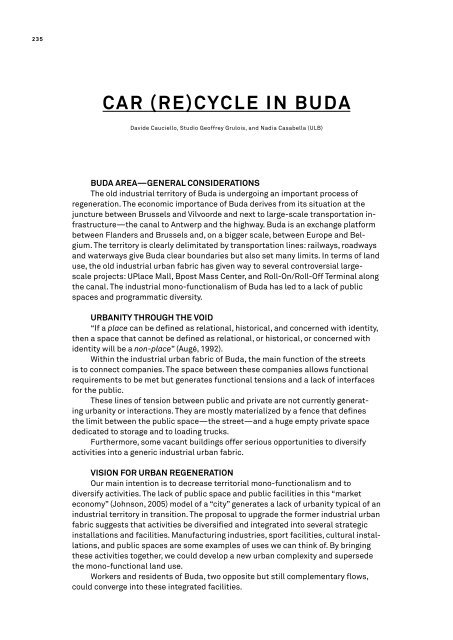DESIGNING TERRITORIAL METABOLISM
978-3-86859-489-8 https://www.jovis.de/de/buecher/product/designing_territorial_metabolism.html
978-3-86859-489-8
https://www.jovis.de/de/buecher/product/designing_territorial_metabolism.html
You also want an ePaper? Increase the reach of your titles
YUMPU automatically turns print PDFs into web optimized ePapers that Google loves.
235<br />
CAR (RE)CYCLE IN BUDA<br />
Davide Cauciello, Studio Geoffrey Grulois, and Nadia Casabella (ULB)<br />
BUDA AREA—GENERAL CONSIDERATIONS<br />
The old industrial territory of Buda is undergoing an important process of<br />
regeneration. The economic importance of Buda derives from its situation at the<br />
juncture between Brussels and Vilvoorde and next to large-scale transportation infrastructure—the<br />
canal to Antwerp and the highway. Buda is an exchange platform<br />
between Flanders and Brussels and, on a bigger scale, between Europe and Belgium.<br />
The territory is clearly delimitated by transportation lines: railways, roadways<br />
and waterways give Buda clear boundaries but also set many limits. In terms of land<br />
use, the old industrial urban fabric has given way to several controversial largescale<br />
projects: UPlace Mall, Bpost Mass Center, and Roll-On/Roll-Off Terminal along<br />
the canal. The industrial mono-functionalism of Buda has led to a lack of pu blic<br />
spaces and programmatic diversity.<br />
URBANITY THROUGH THE VOID<br />
“If a place can be defined as relational, historical, and concerned with identity,<br />
then a space that cannot be defined as relational, or histo rical, or concerned with<br />
identity will be a non-place” (Augé, 1992).<br />
Within the industrial urban fabric of Buda, the main function of the streets<br />
is to connect companies. The space between these companies allows functional<br />
requirements to be met but generates functional tensions and a lack of interfaces<br />
for the public.<br />
These lines of tension between public and private are not currently generating<br />
urbanity or interactions. They are mostly materialized by a fence that defines<br />
the limit between the public space—the street—and a huge empty private space<br />
dedicated to storage and to loading trucks.<br />
Furthermore, some vacant buildings offer serious opportunities to diversify<br />
activities into a generic industrial urban fabric.<br />
VISION FOR URBAN REGENERATION<br />
Our main intention is to decrease territorial mono-functionalism and to<br />
diversify activities. The lack of public space and public facilities in this “market<br />
economy” (Johnson, 2005) model of a “city” generates a lack of urbanity typical of an<br />
industrial territory in transition. The proposal to upgrade the former industrial urban<br />
fabric suggests that activities be diversified and integrated into several strategic<br />
installations and facilities. Manufacturing industries, sport facilities, cultural installations,<br />
and public spaces are some examples of uses we can think of. By bringing<br />
these activities together, we could develop a new urban complexity and supersede<br />
the mono-functional land use.<br />
Workers and residents of Buda, two opposite but still complementary flows,<br />
could converge into these integrated facilities.


















